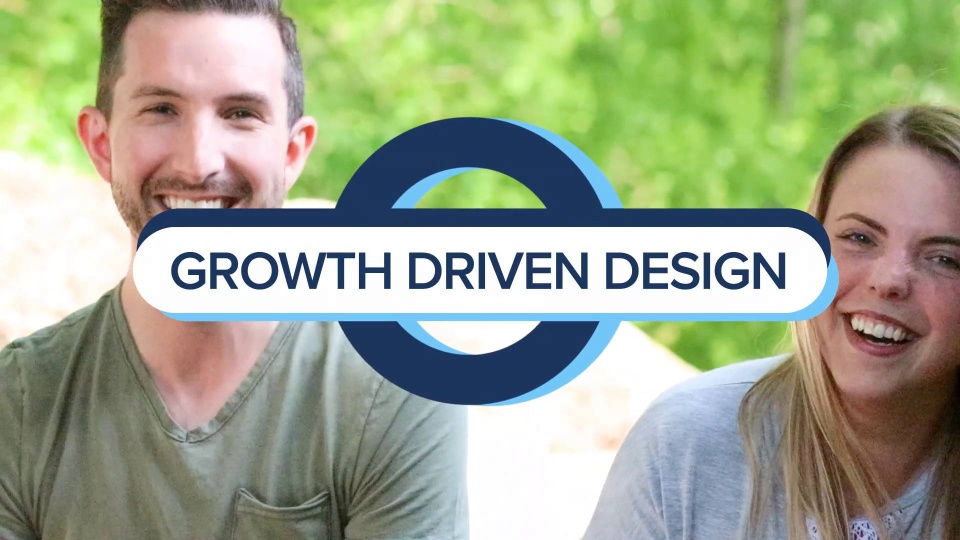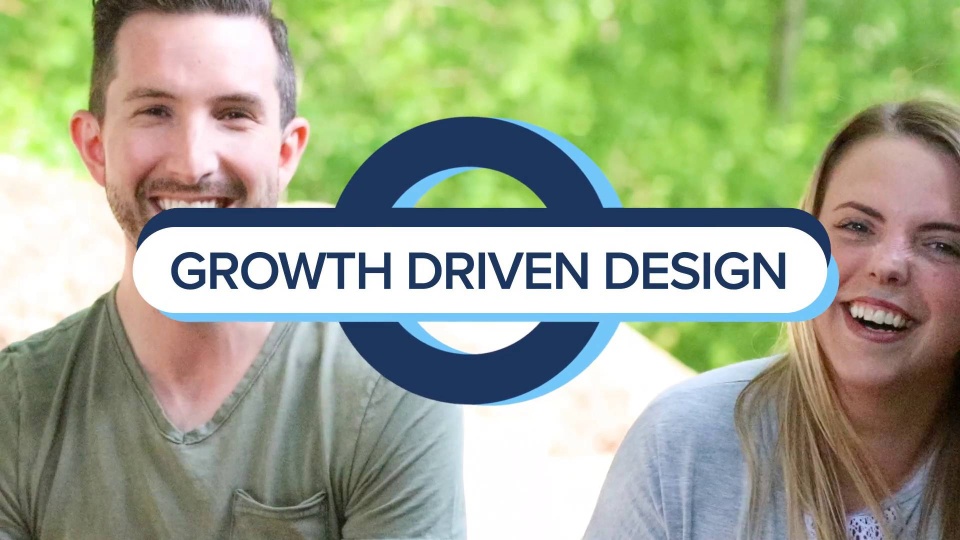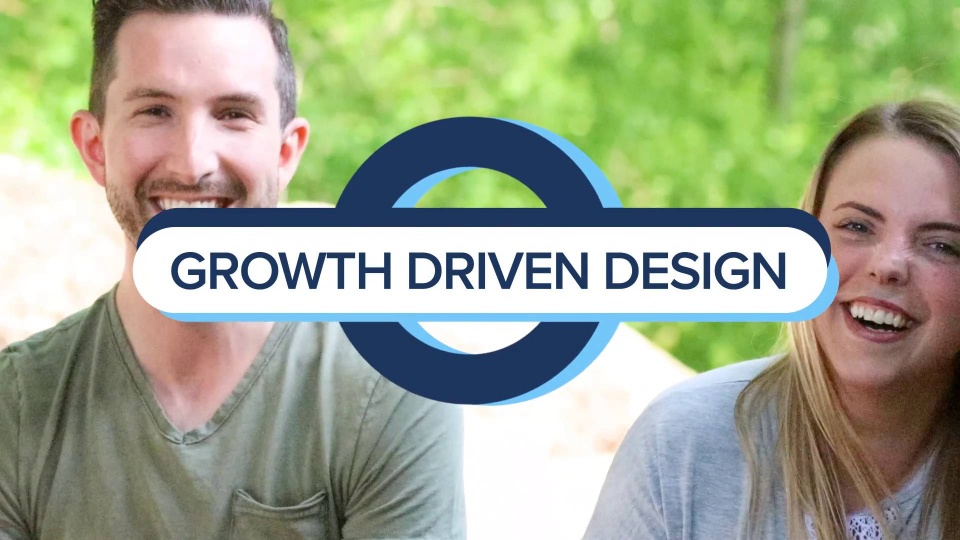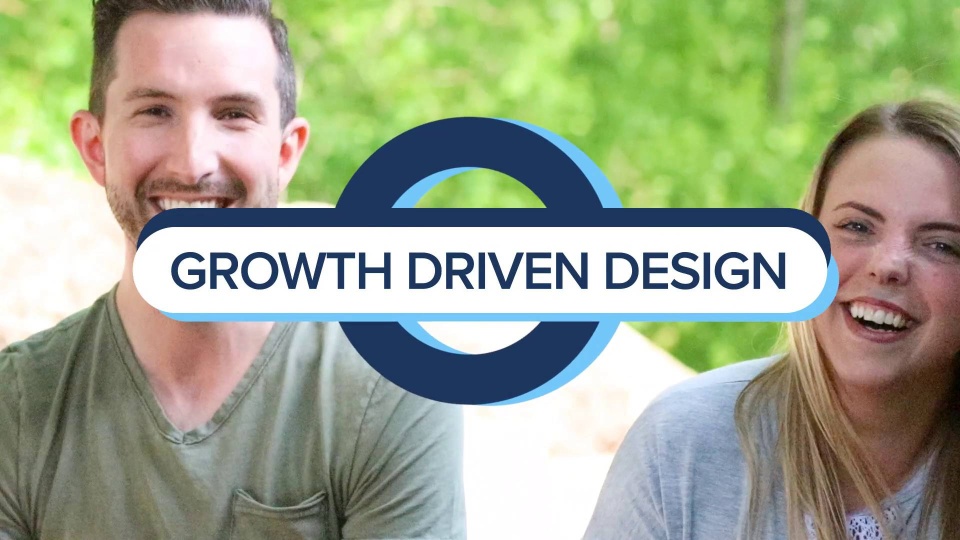(GDD) Websites
In a nutshell, GDD is a more efficient and productive method of building and maintaining a website because it results in a faster launch of an initial site, and it leverages user data to inform continuous improvements to the site.

Table Of Contents
The Growth-Driven Design (GDD) Methodology
Twenty years ago, when most companies were just starting to understand the value of a web presence, the process of building one was rather taxing: take 3 or 4 months to decide what the stakeholders want on the site, then 4 months or more developing it. At that point the job was done, and the site was left to do its thing…the world keeps changing, while the site sat static until it was declared obsolete. Then, the process started all over.
Today, marketers are smarter and many have turned to the GDD approach – one that’s far more effective in consistently attracting and engaging the right prospects to their companies’ websites.
A GDD website approach is:
- Iterative. Unlike a traditional process, in which the plan-develop-launch-watch cycle typically spans 3-5 year or longer, a GDD site is developed and continually improved over a perpetual cycle of sprints. Sprints are defined time periods (typically one or two weeks) during which a company’s marketing team or marketing partner work on data-driven improvements to the site.
- Focused on the user. The improvements that are made during these sprints (sometimes called continuous improvement cycles) aren’t based solely on the opinions of the company’s marketing or management teams; they’re changes that are based on how prospects are using (and not using) the site. In other words, the site is always being improved based on data that tells you how your prospects are engaging with your site.
- Optimized. Most importantly, a GDD site is in a continual state of optimization – meaning, it’s always being improved to give prospects what they’re looking for, and to deliver the highest number of visitors, leads and customers.
Watch: Why Implement GDD?

Growth-Driven Design
What is GDD? Perhaps the best way to describe growth-driven design (GDD) is to compare it to the “old” way of developing websites. The chart below captures the most obvious differences between the two approaches.
This comparison highlights the most important benefits of a GDD website – reduced time-to-launch, consistent budgeting and, most importantly, the optimization of the site. Using ongoing improvement cycles, GDD websites are always being optimized, making them the hardest-working, most powerful sales tool a company has.
Watch: GDD vs Traditional Website Design

GDD Work?
The GDD methodology will be familiar to industrials and software companies, as it’s a hybrid of Lean and Agile methodologies. Both streamline and formalize workflows to gain the greatest efficiencies and performance. GDD also takes UX (user experience) principles into account to ensure visitors have the most productive experience on the site.
There are three phases in the development and maintenance of a GDD website:
Strategy
During the strategy phase, the team sets SMART goals (Specific, Measurable, Achievable, Relevant and Timely), identifies the most powerful keywords to include on the site, evaluates user behaviors (how they currently use your site), makes assumptions about additional/better ways to engage users, creates a wish list of actions to take to modify the site based on those assumptions, and sets a design and message strategy. This stage typically takes around 2 to 4 weeks.
Phase I: Develop Your Strategy
During the strategy phase, goals of the site are clearly defined (and should align with and help you reach your overall business goals). These goals should be SMART: specific, measurable, achievable, relevant and time-bound.
Work To Be Completed During This Phase
Buyer Personas
During the strategy phase you need to make sure you’ve clearly understood and defined your best prospects by developing buyer personas. Buyer personas identify a wealth of valuable information about your prospects:
- Roles within their companies
- Professional motivations
- Challenges and pain points
- Obstacles they need to overcome to recommend or purchase your product
- Questions he or she wants answered throughout the buyer’s journey
- Other demographic and psychographic information that give you a sense of their “whys” and “hows”
Buyer’s Journeys
At this same time, you need to map each persona’s buyer journey — the process he or she goes through as they search for solutions. A buyer’s journey document will tell you:
- How long the journey typically takes (sales cycle)
- How much do they need to learn at each stage (Awareness, Consideration, Decision)?
- What’s the nature of the information they need at each stage?
- What questions do they need answered at the different buyer journey stages?
Personas and buyer journeys provide valuable insights that allow you to build a site based on prospect and customer alignment, not on guesswork.
Other work you’ll need to do during the strategy phase includes:
Positioning
Your positioning — what you represent to whom in what market — essentially answers the questions, “What do customers gain by working with you?” and “What do you do better than your competitors?” This step ensures that your messaging and what you offer your site’s visitors are aligned with prospects’ needs and accurately communicates the value your brand brings them.
Search Engine Optimization (SEO)
For your site to get found online by prospects searching for solutions like yours, you’ll need to incorporate keywords and keyword phrases very similar to those they enter into their search bars. Search engine optimization (SEO) is part art, part science, and includes learning as much as you can about how your prospects are searching (and what they’re searching for), then integrating what you’ve learned into your content, such as blog posts and page content, and the content you offer for download, like ebooks, guides, tipsheets, videos and others.
Determine the Structure and Content of the Launch Pad Site
While GDD is intended to eliminate much of the guesswork involved in maintaining a website, some assumptions must be made upfront for your initial launch pad site. Your team should already have a good idea, for example, of the main pages needed to tell prospects what they want and need to know. You’ll want to include as many stakeholders as possible to ensure that all opinions regarding priorities are considered before making these important decisions.
Brainstorm a Wish List
You can only include so much in your launch pad site, and anything that’s not imperative will be put on a wish list. This list will outline all the things you’d like to add to or modify (but keep your goals in mind in order to keep the list from being an “any and all” dumping grounds). In creating this list, prioritize the actions you’ll take based on the potential of each to impact the site’s performance. You’ll refer to this list once it is launched; at that point, you’ll begin chipping away at the wish list during sprints.
Launch Pad
Phase II: Build the Launch Pad Website
At this

Refresh
This approach works well for companies with relatively new websites (less than two years old) that perform fairly well based on industry standards. When using this approach to build your GDD site, though, it’s important to look critically at your existing site to determine if it truly aligns with your new strategy, or if more than a Refresh is needed to reach your goals.
Example: An OEM that makes blades for the agriculture industry recently completed a new site, but without any of the elements needed to attract and convert leads (content offers, landing page conversion forms, automation and a blog, among other things). Because the site is new, little design is required and the overall messaging and navigation are good, but the items listed must be part of the launch pad site.
Kickstart
When your site doesn’t accurately communicate your brand — when the design is outdated and messaging isn’t aligned with your goals — you need an entirely new site, plus all the elements mentioned above (content offers, landing page conversion forms, automation, blog, etc.).
Using the example above, if this same OEM hadn’t updated its site just a few years ago, the Kickstart would be the most practical choice because the communication strategy would need to be developed and implemented, along with new site architecture and navigation, new functionality, etc.
Launch & Expand
Companies with large websites sometimes take this approach, which involves building in phases, constructing the most important parts of the site first, then other areas in order of value/impact. That might mean that entire sections (shopping cart, history page, Q&A page, etc.) might not be part of the launch pad site but are added later.
Using the example again, if that same OEM example had a multinational site with more than 75 pages and eCommerce capability, a Launch & Expand approach would work best. It’s important with this method to first focus on completing sections of the site that will have the greatest impact and potential to generate leads.
The next stage is the development of an initial – launch pad – site. The launch pad site will include all the components you’ve determined in the strategy stage to be the highest priority. With only these “must-haves” part of the site, you launch sooner – and start getting results sooner – than you would in a traditional approach. This stage is usually completed in 60 to 90 days, depending on the scope of the site.
Continuous Improvement
Once up and running, the launch pad site will begin to generate data that informs upcoming changes, performed in ongoing “sprints” of work. What might remain on the strategy-phase wish list are rolled over into the next sprint, though at any time items can be deleted or added.
Phase III: The Continuous Improvement Cycle
Once your
Audience alignment
These are changes that make the site and its content more relevant to your best prospects and to your customers.
Value to the audience
These changes make the content itself more useful to prospects and customers. For example, a calculator that allows someone to determine costs based on different scenarios is more valuable than a static price list.
Usability
Changes that fall into this category improve visitors’ experiences with the site, making it easier to navigate, more intuitive or easier to find what they need.
Conversion rate optimization
These types of changes boost the number of visitors who provide contact information (in return for a downloadable piece of content), an action that turns them into leads.
Stickiness
Stickiness keeps people on a page(s) and on the site longer. Types of changes that are considered to be in this category would be greater topic value, useful or interesting functionality, video, and internal links to related content.
Personalization
Content
Adding additional content offers, adding pages to the site or modifying existing content are all examples of content changes.
Attraction
Improving search engine optimization by including keywords with greater potential to attract your best prospects.
Promoters
Not all changes made to a site are aimed at prospects. To ensure that your customers are your advocates and promoters, a number of site changes can be made to ensure their ongoing satisfaction with your company.
Continuous Improvement Cycle Process
During each CI Cycle, the team will go through Plan, Build, and Learn & Transfer phases. These are essentially the same steps you took to build your launch pad site (Strategize, Build, Continuous Improvement), but are done within time-bound sprints and based on data you gather from your site and your wishlist items:
Plan
During this step you’ll review site analytics and form insights that allow you to make the best decisions about the changes to be made. Using user data generated by the site, you’ll determine what visitors are looking at, what they’re not, how long they’re spending on your site and its specific pages, and many other metrics that tell how your site is performing. Then, you’ll focus on changes you believe will have the greatest potential to get you to your goals (set in the strategy phase), and make hypotheses about the actual impact your changes will have.
Build
The majority of the CI cycle will be spent making the changes you’ve identified from the planning stage and your existing wish list, prioritized based on potential impact.
Learn & Transfer
After the CI sprint changes are made, before starting another you need to:
- Review how the site is performing against goals
- Use the information to groom your existing wish list — remove items that you decide aren’t going to deliver value and add any you think will
This Plan, Build, Learn & Transfer cycle is repeated continually. As you can see, GDD is a process that teaches you more and more about your site’s users with every continuous improvement cycle. That knowledge is used to improve the site and its metrics, and improve the quantity and quality of leads coming to your site.
Growth-Driven Design Website Cost?
Every inbound program is different, and each is aligned with specific industry and company needs and goals. But there are a few “must have” components for any inbound program to work well: social media promotion (especially on LinkedIn), regular content creation (blogs, tipsheets, videos, etc.), email marketing, search engine optimization and analytics. These are like cogs in an engine moving in an integrated way – one fueling the other – and they’re most effective when powered via a single platform (like the HubSpot software).
It’s tempting to say that GDD is a less expensive approach to website maintenance and design, but that’s somewhat misleading — you may spend about the same as with a traditional approach. The more important benefits of this approach include:
- You’re spreading the cost of a website out over time. There’s a larger “first round” cost to build the launch pad site, but smaller (and consistent) monthly costs thereafter as you continually improve it
- You’re ensuring that the right work gets done first, and continue to do the work that improves the site’s performance
- You’re generating leads more quickly, another way you’re getting better return on investment
- And, because it’s always in a state of optimization, you’re getting a higher quality and number of leads with each cycle. Your site is becoming a stronger, more powerful sales tool
Watch: Is GDD a Good Fit For You?




